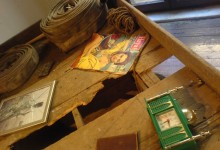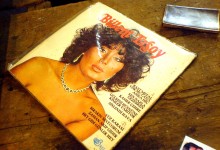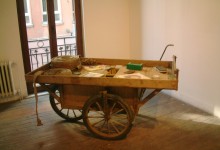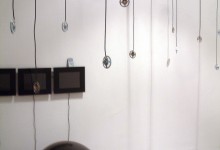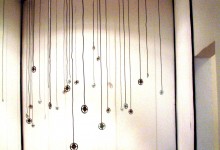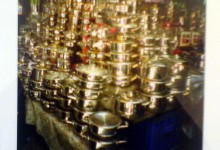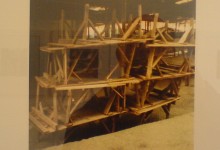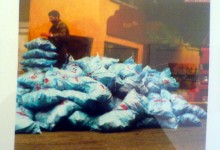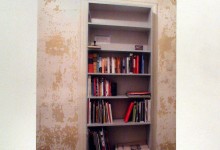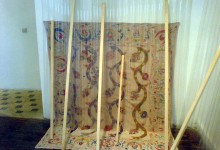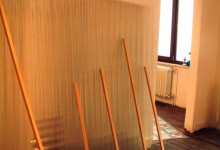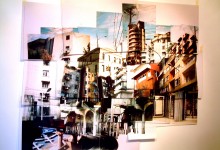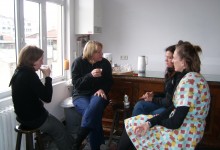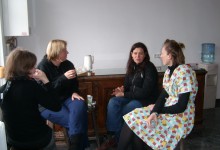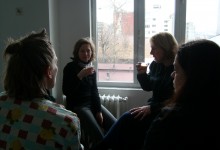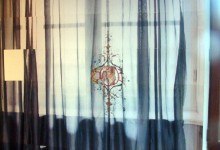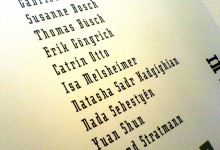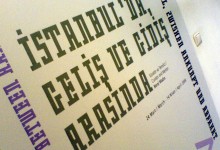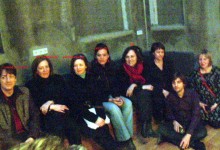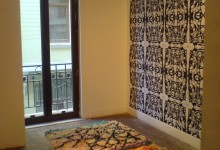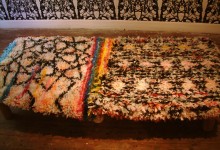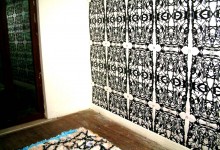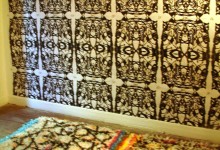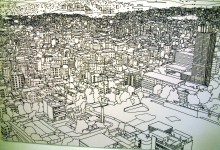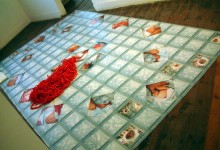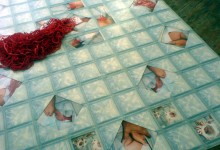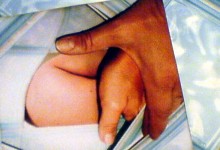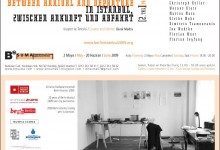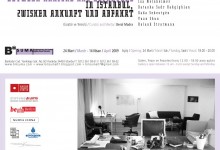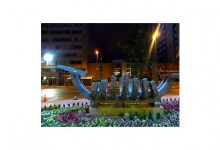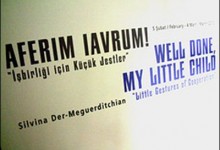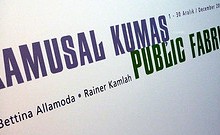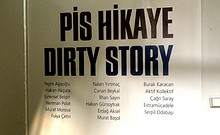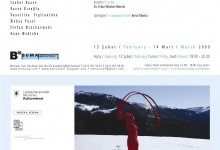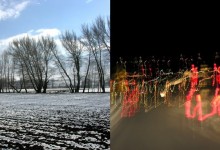BASIN BÜLTENİ-BERLIN -ISTANBUL BURSU
IN ISTANBUL BETWEEN ARRIVAL AND DEPARTURE I/ ISTANBUL’DA GELİŞ VE GİDİŞ ARASINDA I
24 MARCH- 14 APRIL 2009
EXHIBITION OF BERLİN SENATE ISTANBUL SCHOLARSHIP ARTISTS /BERLİN SENATOSU ISTANBUL BURSU SANATÇILARI
GABRIELE BASCH, SUSANNE BOSCH, THOMAS BÜSCH, ERIK GÖNGRICH, NATASHA SADR HADGIGHIAN, ISA MELSHEIMER, CATRIN OTTO, NADA SEBESTYEN, YUAN SHUN, ROLAND STRATMAN CURATOR AND MENTOR: BERAL MADRA
IN ISTANBUL BETWEEN ARRIVAL AND DEPARTURE II/ ISTANBUL’DA GELİŞ VE GİDİŞ ARASINDA II
2 MAY – 20 JUNE 2009
EXHIBITION OF BERLİN SENATE ISTANBUL SCHOLARSHIP ARTISTS / BERLİN SENATOSU ISTANBUL BURSU SANATÇILARI
BERNARDO GEORGI, NEZAKET EKİCİ, KATJA EYDEL, PARASTOU FOROUHAR, MONA JAS, CHRISTOPH KELLER, WERNER KLOTZ, MARISA MAZA, ULRIKE MOHR, DIMITRIS TZAMOURANIS, INA WUDTKE, FLORIAN WÜST, FLORIAN ZEYFANG
CURATOR AND MENTOR: BERAL MADRA
In 2009 Berlin – Istanbul Twin City 20th year Jubilee will be celebrated. In 1988 Berlin Mayorship has established a one year or six months artist residency scholarship for Berlin resident artists for London, Los Angeles, Istanbul, Moscow and Paris. Istanbul residency has hosted almost 70 artist mentored by the writer Sezer Duru and the deceased designer Harald Schmidt from 1988 to 1994 and administrated and mentored by Beral Madra since then. Every year in December a jury consisting of members from the aforementioned cities and the experts from Berlin institutions evaluate approximately 100 applications and select the artists. This year as the Istanbul branch of the Berlin Scholarship we are celebrating the 20th year of this initiative with an exhibition of 23 artists who has lived and worked in Istanbul since 1998. The exhibition will be realized in two parts.
Birinci Bölümde GABRIELE BASCH, SUSANNE BOSCH, THOMAS BÜSCH, ERIK GÖNGRICH, NATASHA SADR HADGIGHIAN, ISA MELSHEIMER, CATRIN OTTO, NADA SEBESTYEN, YUAN SHUN, ROLAND STRATMANN
İkinci Bölümde BERNARDO GEORGI, NEZAKET EKİCİ, KATJA EYDEL, PARASTOU FOROUHAR, MONA JAS, CHRISTOPH KELLER, WERNER KLOTZ, MARISA MAZA, ULRIKE MOHR,DIMITRIS TZAMOURANIS, INA WUDTKE, FLORIAN WÜST, FLORIAN ZEYFANG
Haziran sonunda Berlin Belediye Başkanı Sayın Klaus Wowereit kutlamalar dolayısıyla İstanbul’a geldiğinde bu burs ve sergi dolayısıyla bir basın toplantısı düzenleyecek.
İstanbul’da yaşayan ve çalışan bu sanatçılar, kentte yaşadıkları altı ay boyunca çeşitli çevrelerle ilişki kurdular, üniversitelerde sunum, genç sanatçılar ya da öğrencilerle çalıştaylar, STK’larla işbirliği yaptılar; kentin mimari ve toplumsal dokunu araştırdılar ve gözlemlerini, yorumlarını ve eleştirilerini yansıtan işler ürettiler. Bu işlerini çoğu kez İstanbul’da grup sergileri içinde ya da kişisel sunumlarda gösterdiler. Bu işlerini İstanbul’dan sonra gittikleri her ülkeye ve her kente de taşıdılar.
BM Suma Çağdaş Sanat Merkezi’ndeki iki sergi, bu yapıtları ilk kez toplu olarak bir araya getiriyor. İstanbul için ve İstanbul üstüne üretilmiş bu yapıt topluluğu, İstanbul 2010 sürecinde de dikkate değer bir anlam taşıyor.
Catalogue Text: Turkish, English, German
IN ISTANBUL, BETWEEN ARRIVAL AND DEPARTURE. . .
I’m waiting in the arrivals hall of Atatürk Airport. The electronic doors glide open and then shut, finally revealing a face that is familiar but now with searching eyes. Normally I get to know the scholarship recipients after the jury meeting in Berlin. I have been doing this twice a year since 1995 Driving the new arrivals into the centre of Istanbul from the airport, I always take them along the road by the Marmara Sea to give them a more striking and expansive view of the city.
I’ve been renting out an apartment to the visiting artists since 1999. It’s located in Tesvikiye, an exclusive residential area in the Sisli district of Istanbul. The apartment itself is modest but spacious. Thanks to a diary kept by all the scholarship recipients, we can see how the artists integrate themselves in everyday life and we hear about the local opportunities as well as the obstacles that would be unexpected in EU cities. This apartment is now an established feature of the art scene. It has become a meeting point for local and international artists, curators and intellectuals – a place for discussion and artistic creativity. It has even entered Istanbul’s history of contemporary art. Each artist transforms the apartment according to his or her own artistic sensibility. Sometimes the walls are empty because the current artist only works with video and photography. But sometimes you see wall paintings and all kinds of installation materials.
After a week or two of adjustment, the visiting artists quickly become involved in the life and culture of the city. They collaborate and work with the local artists and art collectives. After a few weeks they can enjoy showing their own visitors around their new world. Here I should mention the efforts of Orhan Esen who gives the visiting artists a glimpse of the “other side” or “true face” of Istanbul. He organises excursions around the constantly expanding metropolis. Orhan Esen is an urban scientist and writer. He published the book Self Service City in which he uses essays, articles, conversations and photographs to analyse the developments in Istanbul. His insights often provide the artists with entirely new perspectives.
In 1998, we staged a large exhibition for the recipients of Istanbul scholarships in the Kunstraum Kreuzberg in Bethanienhaus. For the first time, the image of Istanbul with all its diversity and heterogeneity was reflected in painting, photography, sculpture and installations. The response from the Turkish population in Kreuzberg was not particularly illuminating. Interest in the exhibition was low because the Istanbul depicted in the artwork was different to how it was pictured in their memories. But the exhibition did generate a stronger interest among the Berlin art scene with a steadily growing number of applications for Istanbul.
Unfortunately, the scholarship is only supported from the German side. If the Istanbul authorities were to offer a Berlin scholarship, it would complete the cultural and political idea. Nonetheless, after a gap of 10 years it is a pleasure to be staging the next exhibition of the Berlin Senate’s scholarship recipients – this time both in Berlin and Istanbul.
Since 1995, the visiting artists from Berlin have been an integral part of my life as a curator. Not only that, they have become an important part of the Istanbul art scene as a whole. Through these contacts, many Turkish artists have been introduced to the German art scene. And many works of art that were created for the Istanbul arena have travelled the world. Various misconceptions about Turkey have been dispelled and changed for the better. Istanbul was still an outpost when this programme began in 1988. Two decades later, Istanbul is an important location in the international art world and the scholarship recipients have witnessed the city’s evolution at first hand. With its highly unique artistic and cultural landscape, Istanbul will be the European Capital of Culture in 2010. This transition was not built on locally-produced art and culture alone – the city has been truly enriched by the contributions of the Berlin artists.
The artists of the new millennium clearly view the making of art as a process, and they get involved in the existing political, social and cultural systems. In this respect, Istanbul provides a heterogeneous reflection of Turkey as a whole – like a massive laboratory. One of the main themes of the artwork produced so far has been the inherent contradictions and ongoing negotiations between Ottoman social and cultural heritage, nation-state modernism and post-modern processes. Another major theme is that of contemporary gender issues and the position of women within the context of feudal family structure. A third theme is the interwoven and palimpsest-like urban structure of the city and the way it sets the parameters for everyday life.
One noticeable trait is the discreet approach that the artists generally adopt towards highly sensitive ideological and political issues such as dogged nationalism, insidious fundamentalism, xenophobia and the veneer of rationalism. This discretion is somehow characteristic of artistic production in Europe. However, the huge political, economic and social pressures in the everyday agendas of countries like Turkey force a direct response from the local artists. The sense of responsibility towards the political and social situation, the ambivalence caused by the rupture between the generations – these intrinsic elements are often reflected in the work of local artists. The visiting artists, on the other hand, prefer a more documentary language with accentuations on assembled realistic images, sounds, texts and objects.
At the moment, the alarm bells are sounding once again for the global economy in general and the Turkish economy in particular. This is not the first time that we’ve experienced this type of situation, and each time it creeps up with various warnings. It is felt most keenly in Istanbul. Since I started working for the European Capital of Culture project for Istanbul 2010, I have been a daily visitor to Istiklal Street – the “free zone” where the triumphal march of globalised culture is celebrated. This is where the political and ideological visions of the different urban communities are manifested. Here, the cultural infrastructure is squashed together. Through the zone of contemporary art institutions and galleries, the visiting artists get involved in local events. They experience everything that the local artists experience. They get excited, they get frustrated, they calm down, and they enjoy themselves. In this sense, ‘the Istanbul scholarship represents an extended trip for the artists. It is a trip that allows them to enhance their “own reality” with an “other reality”. It is a trip that lets them get to know a different place – to experience it and add it to their personal map of the art world. It is a trip that gives them the opportunity to use their work and ideas to restructure and reinvigorate an outmoded, stereotypical and exhausted world view. An Istanbul scholarship is a purposeful and rewarding trip.’*
It begins with arrival at Atatürk Airport. But departure six months later is not the end of the affair. Istanbul leaves its mark for ever upon all those who wish to discover the city…
*from the catalogue Istanbul in Berlin. Die Berliner Istanbul Stipendiaten 1988-1989, Kunstraum Kreuzberg, Berlin
IN ISTANBUL, ZWISCHEN ANKUNFT UND ABFAHRT…
Ich warte im Ankunftssaal des Atatürk Flughafens. Die elektronische Tür gleitet auf und zu und endlich kommt das bekannte Gesicht, mit suchenden Augen. Zumeist kenne ich die Künstler/innen, die das Stipendium erhalten haben und die ich bereits nach der Auswahlsitzung in Berlin kennen lernen konnte. Vom Flughafen in die Stadtmitte fahre ich sie immer die Straße am Marmara Meer entlang, damit die Neuankömmlinge einen weiten Blick auf die Stadt bekommen.
Seit 1999 habe ich eine Wohnung für die Stipendiaten angemietet. Die Wohnung liegt in Teşvikiye, einem vertrauten und vornehmen Istanbuler Wohnviertel, im Bezirk Şişli. Die Wohnung ist bescheiden aber geräumig. Ein Tagebuch, das von allen Stipendiaten genutzt wird, zeigt uns die intime Einbindung der Künstler/innen in das tägliche Leben, in die lokale Möglichkeiten sowie auch Hindernisse, die in EU Städten nicht zu erwarten sind. Diese Wohnung ist bereits in der Kunstszene bekannt. Sie wurde ein Treffpunkt für lokale und internationalen Künstler/innen, Kuratoren, Intellektuelle und zum Ort der Diskussion und des künstlerischen Schaffens. Sie ist bereits in der zeitgenössischen Kunstgeschichte Istanbuls registriert.
Jede der Künstler/innen hat die Wohnung nach ihrem/seinem eigenen Kunstverständnis umgewandelt; manchmal sind die Wände leer, weil derjenige/diejenige nur mit Foto und Video arbeitet; manchmal aber sieht man Wandmalerei und viele Installations-Materialien. Ein Zimmer ist als Sammelstelle für unverwendeten Krims Krams reserviert; das ich ab und zu mal ausräumen muss.
An Isolation oder Einsamkeit ist hier nicht zu denken. Die Künstler/innen sind in kurzer Zeit intensiv in das Leben und in die Kultur der Stadt involviert. Viele lokale Künstler und Künstlergruppen nehmen sich den Künstler/innen an. Besucher aus Deutschland oder aus anderen EU Länder sind oft mit integriert. Nach einigen Wochen führen die Stipendiaten sogar ihre Besucher gerne in diese Welt ein. Jedoch möchte ich hier den Beitrag von Orhan Esen erwähnen, der den Stipendiaten “das wahre Gesicht” Istanbuls, zeigt. Er organisiert Exkursionen zu dem “anderen” Istanbul. Orhan Esen ist ein Stadt Forscher und Schriftsteller. Er hat das Buch „Self Service City“ publiziert, das analytische Texte, Artikel, Gespräche und Bilder über Istanbul anbietet. Durch seine Hinweise eröffnen sich den Künstler/innen oft vollkommen neue Visionen.
Die künstlerische Produktion während des Aufenthalts und die Präsentation fand immer eine adäquate Plattform. Entweder in Form einer Beteiligung an einer Gruppen Ausstellung oder als Einzelauftritt in der Form einer Aufführung oder einer Video-Dokumentation.
1989 haben wir mit Marlis Micha, der damaligen und gegenwärtigen Mitarbeiterin des Referats Kulturaustausch der Senatsverwaltung für Wissenschaft, Forschung und Kultur und Krista Tebbe, der damaligen Direktorin vom Kunstraum Kreuzberg eine umfangreiche Ausstellung des Berliner Senats für die Istanbul Stipendiaten im Kunstraum Kreuzberg im Bethanienhaus, realisiert. Das Istanbul Bild mit seinen Diversitäten und Heterogenität wurde zum ersten Mal in Malerei, Photographie, Objekten und Installationen reflektiert. Wie diese Ausstellung damals von den Kreuzberg Türken aufgenommen wurde, war für mich nicht sehr aufschlussreich. Das Interesse war gering, da Istanbul in diesen Werken ziemlich anders war als in dem Gedächtnis der Immigranten. Diese Ausstellung provozierte ein frisches Interesse in dem Berliner Kunstmilieu; die Bewerbungen für Istanbul wurden immer zahlreicher.
Dieses Stipendium ist eine nachhaltige Kultur-Politik, die leider nur von Deutscher Seite aus durchgeführt wird. Ein Berlin Stipendium von der Seite der Istanbul Munizipalität könnte diese Politik vervollständigen. Jedoch, nach 10 Jahren ist es wieder eine Freude, die Ausstellung der Berliner Senats Stipendiaten zu realisieren, diesmal in Istanbul.
Seit 1995 sind die KünstlerInnen aus Berlin nicht nur ein untrennbarer Teil meines Lebens als Kuratorin, sondern auch ein wichtiger Bestandteil in der Istanbuler Kunstszene. Durch diese Künstler/innen sind viele Türkische Künstler in die deutsche Kunstszene hineingeführt worden, viele Kunstwerke, die für Istanbul geschaffen wurden, durch die Welt gereist. Es wurden viele Vorurteile über die Türkei abgebaut und zum positiven verändert.
Mit seinem sehr eigenen künstlerischen und kulturellen Panorama wird Istanbul die Kulturhauptstadt Europas 2010. Als 1988 dieses Stipendium anlief, war Istanbul noch ein Außenposten und die Stipendiaten dieser Jahre haben die Entwicklung miterlebt. Nach zwei Jahrzehnten ist Istanbul ein wichtiger Ort in der internationalen Kunstszene. Dies wurde nicht nur mit der lokalen Kunst- und Kulturproduktion aufgebaut, sondern auch durch die Beiträge der fremden Bahnbrecher bereichert, unter denen die Stipendiaten aus Berlin besonders wichtig sind.
Die Stadtentwicklungspolitik ist das wichtigste Kapitel im Kulturhaupstadtprogram Istanbul 2010. Die Stadtviertel- und Altbausanierung, Renovierung der historischen Gebäude, öffentliche kulturelle Bildung, alles was bislang zur Grundausstattung dieser globalen Stadt gehörte ist nun Hauptthema geworden. Durch dies Projekt ist die Stadt nicht nur reich an Hoffnungen, sondern auch an Möglichkeiten und Visionen. Bis jetzt haben viele der Stipendiaten diese Themen wie z.B. die Kultur-Infrastruktur, die komplizierte Beziehungen zwischen Tradition und durch Modernismus und Post-Modernismus umgewandelte Formen und Konzepte, die Perversität in den Prozessen des Nationalismus sowie die Globalisierung beobachtet und recherchiert und daraufhin ihre Werke entwickelt. Damit haben sie schon eine visuelle Ansammlung von Kriterien, Zitaten, Entschlüsse, Interpretationen und Kritik über die kulturelle, soziologische und urbanistische Fakten und Figuren der Stadt geschaffen. Diesen künstlerischen Datenblock in seiner Gesamtheit auszustellen wird neue Aufmerksamkeit wecken und eine neue Debatte eröffnen. Die Fragen sind offensichtlich: Wie sehen diese kreativen Besucher diese Stadt? Wie haben sie ihre Kenntnisse und Vorurteile bearbeitet? Wie wird die eigentümliche türkische Moderne und Post-Moderne interpretiert?
Es ist erkennbar, dass die Künstler/innen des Millenniums, die Kunstproduktion als ein Prozess und als eine relationale Ästhetik auffassen und in die politischen, sozialen und kulturellen Ideologien, Systeme und Konventionen eingreifen. In dieser Hinsicht bildet Istanbul ein heterogenes Spiegelbild der Türkei, offenbar ein umfangreiches Labor. Die Haupthemen der bis jetzt produzierten Werke sind z. B. die Widersprüchlichkeit und Anpassung zwischen Osmanischer Kultur und dem staatlichen Einsatz der Moderne, die soziale und kulturelle Wirklichkeit der türkischen Gesellschaft die sich in die Wirklichkeit der Frauen und die der Männer spaltet und die Geschlechts Probleme ausschließt. Weiterhin die verworbene urbane Struktur der Stadt, die die Parameter des täglichen Lebens bestimmt. Was auffällt, ist die diskrete Einstellung der Künstler/innen zu den sehr kniffligen ideologischen und politischen Themen wie z.B. dem beharrlichen Nationalismus, dem hinterlistigen Fundamentalismus, dem kaschierten Rationalismus und Xenophobie; jedoch ist diese Diskretion eine Eigenschaft des Kunstmachens in Europa. Die politische, ökonomische und soziale Notlage in der täglichen Agenda der Länder wie der Türkei, fordert eine unmittelbarere Kunstanfertigung von den lokalen Künstler/innen. Das Verantwortungsgefühl gegenüber den politischen und sozialen Umständen, die Ambivalenz, die durch die Zerrissenheit zwischen den Generationen entstanden ist, ist oft in den Werken immanent reflektiert. Nach meiner Beobachtung versuchen die Stipendiaten sich an die komplexen geo-politischen Probleme der Türkei über Istanbul anzunähern und zu verstehen, wie die Welt aus der Perspektive eines in Istanbul lebenden Menschen aussieht.
Zurzeit schlägt die Welt-Ökonomie wieder einmal Alarm und damit auch die Ökonomie in der Türkei. Es ist nicht das erste Mal, dass wir das erleben; es kommt jedoch jedes Mal schleichend mit Warnungen oder Mahnungen. Am deutlichsten spürt man dies in Istanbul. Seitdem ich für das Europäische Kulturhauptstadt Projekt Istanbul 2010 arbeite, bin ich jeden Tag in der İstiklal Strasse, der “freien Zone” der Stadt wo die Multi-Kultur ihren Triumph genießt. Dort findet die politische und ideologische Manifestation der verschiedenen Kommunen der Stadt statt. Die kulturelle Infrastruktur ist dort dicht zusammengedrängt. Dort sind auch die Stipendiaten in die lokalen Ereignisse involviert, sie erleben alles was die lokalen Künstler/innen erleben, sie freuen sich, sie ärgern sich, sie beunruhigen sich, sie vergnügen sich… In diesem Sinne ist das Istanbul Stipendium für die Künstler/innen eine erweiterte Reise. Durch diese Reise haben sie ihre “heimatliche Realität” mit der “anderen Realität” ergänzt. Durch diese Reise haben sie den anderen Ort kennengelernt, erlebt und in den gegenwärtigen Kunstatlas eingegliedert. Diese Reise gab ihnen die Möglichkeit, das veraltete oder erschöpfte Weltbild und die stereotypische Anschauung mit ihren Aussagen und Werken wieder aufzubauen, neu zu aktivieren. Ein Istanbul Stipendium ist eine gezielte und eine sich lohnende Reise.* Es fängt mit dem Ankunft am Atatürk Flughafen an; jedoch ist die Abfahrt nach sechs Monaten nicht das Ende dieses Aufenthaltes; Istanbul prägt seine Hoheitszeichen auf die Menschen, die die Stadt entdecken wollen, für immer…
Beral Madra,
*aus dem Katalog „Istanbul in Berlin. Die Berliner Istanbul Stipendiaten 1988-1989“, Kunstraum Kreuzberg, Berlin
ISTANBUL‘DA, GELİŞ VE GİDİŞ ARASINDA…
Atatürk hava limanında geliş salonunda bekliyorum. Elektronik kapılar açılıp kapanıyor, nihayet bir tanıdık yüz görünüyor ve arayan gözlerle etrafa bakınıyor. Bu bursu kazanan sanatçıları çoğu kez tanıyorum, çünkü Berlin’de seçici kurul toplantısından sonra onlarla buluşuyorum. Havaalanından çıkışta onları, kenti daha geniş bir bakış açısıyla görmeleri için her zaman Marmara denizi boyunca uzanan caddeden kentin merkezine götürürüm.
1999’dan bu yana Berlin Senatosu İstanbul burs sanatçıları için kiraladığım apartman dairesi, Şişli ilçesinde tarihsel diyebileceğimiz bir semt olan Teşvikiye’dedir. Daire mütevazı ama geniştir. Burada yaşayanların hemen hepsinin içine bir şeyler yazdığı günlük, bize sanatçıların gündelik yaşamla, yerel olanaklarla ve dahası AB kentlerinde görmedikleri zorluklarla nasıl başa çıktıklarını gösterir. Tüm sanat ortamı bu apartmanı tanıyor artık; yerel ve uluslararası sanatçıların, küratörlerin, aydınların bir buluşma yeri, bir tartışma ve yaratıcılık yeri oldu, burası. İstanbul’un çağdaş sanat belleğine kaydoldu.
Sanatçıların hepsi daireyi kendi sanat anlayışına göre değiştiriyor; kimi zaman sanatçı fotoğraf ve video ile çalıştığı için duvarlar boş; kimi zaman da duvarlarda resimler ve etrafta yerleştirme malzemeleri görülüyor. İlk birkaç alışma haftasından sonra buradaki yaşamlarında yalıtılmışlık ve yalnızlık söz konusu değil. Sanatçılar çok kısa sürede kentin yaşamına ve kültürüne derinlemesine karışıyorlar. Yerel sanatçılar ve sanatçı gruplarıyla işbirliği oluşuyor. Almanya’dan ve diğer AB kentlerinden ziyaretçiler de buna katılıyor. Kısa bir sürede sanatçılar Avrupa’dan gelen ziyaretçilerine rehberlik bile ediyor. Bu bağlamda, sanatçılara İstanbul’un „gerçek yüzü“nü gösteren Orhan Esen’in katkılarını belirtmek isterim. Bir kent araştırmacısı ve yazar olan Esen İstanbul’un çeperine açıklamalı geziler düzenliyor. Yakın zamanda İstanbul üstüne çözümsel metinler, makaleler, söyleşiler ve fotoğraflar içeren „Self Service City“ adlı kitabını yayınladı. Onun yönlendirmeleri sanatçılara çoğu kez yeni görüşler kazandırıyor.
Bu burs süresince üretilen yapıtlar bir grup sergisine katılımla ya da kişisel bir video-belgesel sunumuyla her zaman bir izleyici kitlesine ulaşıyor. 1989’da dönemde ve şimdi Senatonun bilim, araştırma ve kültür alış-verişi biriminin yöneticisi olan Marlis Mischa ve Kunstamt Kreuzberg’in o dönemdeki yönetici Krista Tebbe ile birlikte, Bethanien binasında Berlin Senatosu İstanbul bursunun geniş kapsamlı bir sergisini düzenledik. Belki de ilk kez olarak İstanbul’un farklılıklar ve heterojenlikler manzarası çağdaş resim, fotoğraf ve yerleştirmelerde yansıtıldı. Bu yeni bakış yüzyıllık Oryentalizimden kurtulma olanağı yaratabilir.
Bu serginin Kreuzberg Türkleri tarafından nasıl algılandığı çok belirgin değil; ilgi azdı, çünkü bu yapıtlarda gösterilen İstanbul, Kreuzberg’li Türklerin belleğindeki İstanbul’dan farklıydı. Buna karşın, sergi Berlin sanat ortamında taze bir ilgi uyandırdı; bu sergiden sonra İstanbul bursuna başvuru sayısı arttı.
1995’den bu yana Berlinli sanatçılar yalnız benim küratörlük yaşamımın ayrılmaz bir parçası değil, aynı zamanda İstanbul sanat ortamının çekim noktalarından birisi. Bu sanatçılar aracılığıyla Türkiyeli sanatçılar Almanya sanat ortamına girebildiler ve İstanbul için ve üstüne üretilmiş birçok yapıt dünyayı dolaştı ve Türkiye üstündeki birçok olumsuz yargı olumluya dönüştü.
Bu burs sürdürebilir bir kültür politikasıdır ve ne yazık ki yalnız Almanya tarafından yürütülmektedir. İstanbul Belediyesinin oluşturacağı bir Berlin bursu bu politikaya bir karşılık verebilir.
Neyse ki 10 yıl sonra Berlin senatosu bursunun sergisini İstanbul’da yapabilmek de sevindiricidir.
İstanbul, kendine özgü sanatsal ve kültürel manzarasıyla 2010’da Avrupa Kültür başkenti olacak. 1988’de, bu burs başladığında İstanbul kutuplaşmış bir dünyada bir sınır karakoluydu ve burs sanatçıları günümüze uzanan gelişmeyi izleyebildiler. Yirmi yıl içinde bu kent küresel harita üstünde sıcak bir nokta oldu. Bu özellik yalnız yerel sanat ve kültür üretimiyle gerçekleşmedi, içlerinde Berlin’i burs sanatçılarının dikkat çekici çalışmalarının da yer aldığı yabancı öncü sanatçıların katkılarıyla da zenginleşti
Kentin çok yönlü gelişme politikası İstanbul 2010’un en önemli bölümü; ilçelerin ve eski mimari dokunun yenileştirilmesi, tarihsel yapıların onarılması, kamusal alanda kültürün yeniden yapılandırılması gibi, bu kentin temel donanımını oluşturan ütopyalar artık yeniden ana konudur. Bu proje ile kent yalnız umutla dolu değildir, olanaklar ve uzak görüşlülük açısından daha zenginleşecektir.
Şimdiye değin burs sanatçıları kültürel altyapı, gelenek ve Modernizm arasındaki karmaşık ilişkileri, Post-modernizmle değişen biçimler ve kavramlar, ulusalcılık ve küresellik süreçlerindeki sapkınlıklar gibi konuları gözlemlediler, araştırdılar ve yapıtlarını bunlar üstüne ürettiler. Bu çalışmalarıyla kentin kültürel, toplumbilimsel ve kentsel gerçekleri ve istatistikleri üstüne ölçütler, dipnotlar, kararlar, yorumlar ve eleştirilerden oluşan görsel bir birikim yarattılar. Bu sanatsal veri birikimini bütünüyle sergilemek yeni bir ilgi uyandıracak ve yeni bir tartışma açacak. Sorular çok açıktır: Bu yaratıcı bireyler bu kenti nasıl görüyor? Bilgilerini ve yargılarını nasıl geliştirdiler? Türkiye’nin kendine özgü Modernizm ve Post-modernizmi nasıl yorumlanıyor? Kentin bugünkü durumu nedir?
Yaşadığımız dönemin sanatçılarının sanat üretimini uzun soluklu bir süreç ve ilişkisel bir estetik olarak ele aldıkları ve siyasal, toplumsal, kültürel ideolojileri, sistemleri ve alışkanlıkları irdeledikleri açıktır. Bu bağlamda İstanbul Türkiye’nin heterojen bir aynasıdır ve hiç kuşkusuz zengin bir laboratuardır da. Bugüne değin üretilmiş yapıtların ana konuları arasında Osmanlı kültürü ile devletçi Modernizmin uyuşmazlığı ya da uyumu, Türkiye toplumunun, kadın ve erkek gerçeğini ayıran ve cinsel sorunları göz ardı eden toplumsal ve kültürel gerçekleri, kentin, günlük yaşam biçimlerini belirleyen, karmaşık mimari dokusu yer almaktadır. Bu sanatçıların, örneğin inatçı ulusalcılık, sinsi köktendincilik, gizli saklı ırkçılık ve yabancı düşmanlığı gibi son derece ikircikli ideolojik ve siyasal konulara karşı temkinli yaklaşımları dikkat çekicidir; yapıtlarda doğrudan doğruya eleştiri gözlenmez. Bu temkinli yaklaşım uluslar arası sanat ortamında sanat yapma tarzıdır. Burs sanatçıları Türkiye’nin siyasal sorunlarına anlayış ve duyarlılıkla yaklaşıyor ve dünyanın İstanbul’da yaşayan bir insanın gözüyle nasıl göründüğünü anlamaya çalışıyorlar. Buna karşın Türkiye gibi ülkelerin günlük gündemlerini bağlayan siyasal, ekonomik ve toplumsal aciliyetler yerel sanatçıların daha dolaysız sanat yapmalarına neden oluyor. Onların yapıtlarında siyasal ve toplumsal olumsuzluklar karşısında duyulan sorumluluk, kuşaklar arasındaki kopukluk ve ikilemler yapıtlara olduğu gibi yansıtılıyor.
Günümüzde küresel ekonomi alarm işaretleri vermeye başladı, Türkiye de bunu yaşıyor. Bunu ilk kez yaşamıyoruz; ancak bu kez bu kriz uyarılarla adım adım geliyor. İstanbul’da da bu ciddi olarak hissedilebilir.
İstanbul 2010 etkinlikleri için çalıştığımdan bu yana her gün, kitlelerin kimlik özgürlüğü zaferlerinin zevkine varabildiği en özgür alan olan Beyoğlu’na geliyorum. Burada kentin çeşitli cemaatlerinin siyasal ve ideolojik manifestoları yapılabiliyor ve kültürel altyapı da buraya sıkışmış durumda. Burs sanatçıları da bu bölgede yerel olayların içine girebiliyor, yerel sanatçıların yaşadıkları her şeyi yaşayabiliyor, sevinebiliyor, kızabiliyor, huzursuz olabiliyor ve eğlenebiliyor. Algılama itkileri sanatçıları başka mahallelere de yönlendiriyor; kırsal geleneklerin sürdürüldüğü, ama neo-liberal kapitalizmin de kışkırtıcı oyunlarını oynadığı o ara- alanlara doğru… Oralarda daha sonraki yapıtları için zengin bir sözsel ve görsel malzemeyle karşılaşıyorlar. İzlenimleri genellikle fotoğraflar, videolar, video-söyleşilerde ya da mekân yerleştirmelerinde ortaya çıkıyor; bunların çekici örnekleri bu sergide görülüyor.
Bu yolculuk Atatürk havalimanında geliş ile başlıyor; ancak altı ay sonra gidiş, bu yolculuğun sonu olmuyor, çünkü İstanbul damgasını, onu keşfetmek isteyenlerin üstüne vuruyor.
Beral Madra

